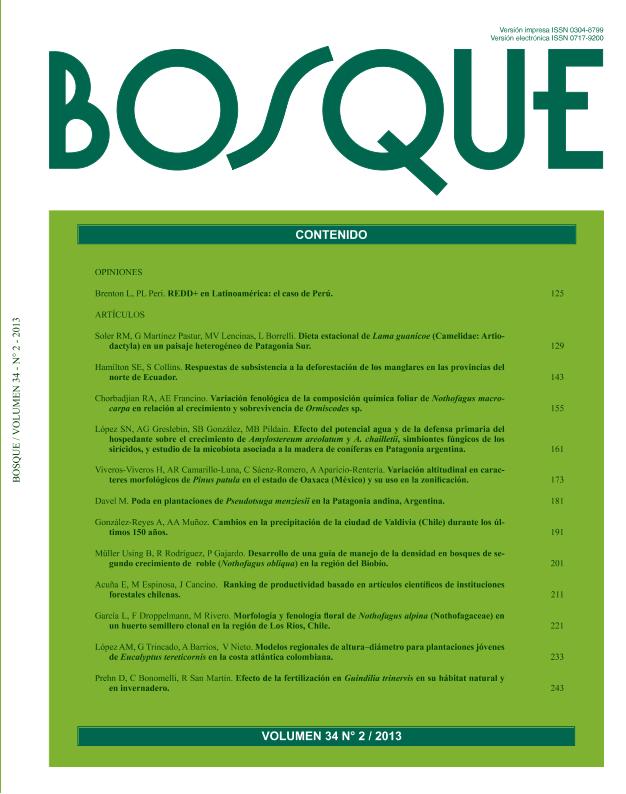Artículo
Amylostereum areolatum y A. chailletii son los simbiontes fúngicos de las avispas barrenadoras de la madera Sirex noctilio y Urocerus gigas, respectivamente. Las especies de Pinus, son susceptibles al ataque del patosistema S. noctilio - A. areolatum, no obstante en Patagonia, se ha observado que la madera apeada de Pseudotsuga menziesii puede ser atacada por U. gigas y su simbionte. En este estudio se evaluó la relación de A. areolatum, A. chailletii y el potencial agua (Ψ0), la defensa primaria de Pinus ponderosa y Pseudotsuga menziesii, y la micobiota endofítica asociada a ambas coníferas. Los Ψ0 se generaron por variación del potencial osmótico; se extrajeron y caracterizaron por GC y GC-MS los aceites esenciales de las oleorresinas constitutivas de la corteza y la albura de ambas coníferas y se evaluó el efecto de compuestos diferenciales y mayoritarios sobre el crecimiento de ambos hongos; la micobiota se analizó a partir de aislamientos de la albura de plantas sanas. Se observó que, el crecimiento de ambos hongos se ve significativamente afectado por el decrecimiento del Ψ0 y que A. chailletii creció más que A. areolatum en Ψ0 más bajos. Las oleorresinas tuvieron un efecto negativo sobre el crecimiento de ambos hongos sin observarse diferencias entre compuestos diferenciales de cada conífera. Hormonema dematioides fue el endófito más frecuente en P. menziesii, ya caracterizado por su influencia sobre el crecimiento de otros hongos, se presenta como una variable a considerar en cuanto al establecimiento del patosistema S. noctilio- A. areolatum Amylostereum areolatum and A. chailletii are fungal symbionts of wood-boring wasp Sirex noctilio and Urocerus gigas, respectively. Pinus species are susceptible to the S. noctilio - A. areolatum pathosystem, and in Patagonia, Argentina, it was found that the felled wood of Pseudotsuga menziesii can be attacked by U. gigas and its symbiont. This study evaluated the relationship of A. areolatum, A. chailletii and water potential (Ψ0), the primary defense of Pinus ponderosa and P. menziesii, and endophytic mycobiota associated to the wood of both conifers. The different Ψ0 were generated by variations in the osmotic potential; constitutive oleoresins of the bark and sapwood of both softwoods were extracted and characterized by GC and GC-MS and the effect of differential and majority compounds on growth of both fungi were assessed; the mycobiota was analyzed from isolates of the sapwood of healthy plants. It was observed that the growth of both fungi is significantly affected by the decrease of Ψ0 and that A. chailletii grew faster than A. areolatum under lower Ψ0. Oleoresins had a negative effect on the growth of both fungi with no differences between conifers. Hormonema dematioides was the most common endophyte on P. menziesii; this fungus is characterized by its influence on the growth of other fungi and appears as a variable to be considered in setting of S. noctilio - A. areolatum pathosystem
Efecto del potencial agua y de la defensa primaria del hospedante sobre el crecimiento de Amylostereum areolatum y A. chailletii, simbiontes fúngicos de los sirícidos, y estudio de la micobiota asociada a la madera de coníferas en Patagonia, Argentina
Título:
Effect of water potential and host defense on the growth of Amylostereum areolatum and A. chailletii, fungal symbionts of siricides, and study of wood associated mycobiota of conifers in Patagonia, Argentina
Fecha de publicación:
08/2013
Editorial:
Universidad Austral de Chile
Revista:
Bosque (valdivia)
ISSN:
0304-8799
e-ISSN:
0717-9200
Idioma:
Español
Tipo de recurso:
Artículo publicado
Clasificación temática:
Resumen
Palabras clave:
Pinus Ponderosa
,
Pseudotsuga Menziesii
,
Essential Oils
,
Hormonema
Archivos asociados
Licencia
Identificadores
Colecciones
Articulos(CCT-CENPAT)
Articulos de CTRO.CIENTIFICO TECNOL.CONICET - CENPAT
Articulos de CTRO.CIENTIFICO TECNOL.CONICET - CENPAT
Citación
López, Sofía Natividad; Greslebin, Alina Gabriela; Gonzalez, Silvia B.; Pildain, Maria Belen; Efecto del potencial agua y de la defensa primaria del hospedante sobre el crecimiento de Amylostereum areolatum y A. chailletii, simbiontes fúngicos de los sirícidos, y estudio de la micobiota asociada a la madera de coníferas en Patagonia, Argentina; Universidad Austral de Chile; Bosque (valdivia); 34; 2; 8-2013; 161-171
Compartir
Altmétricas




